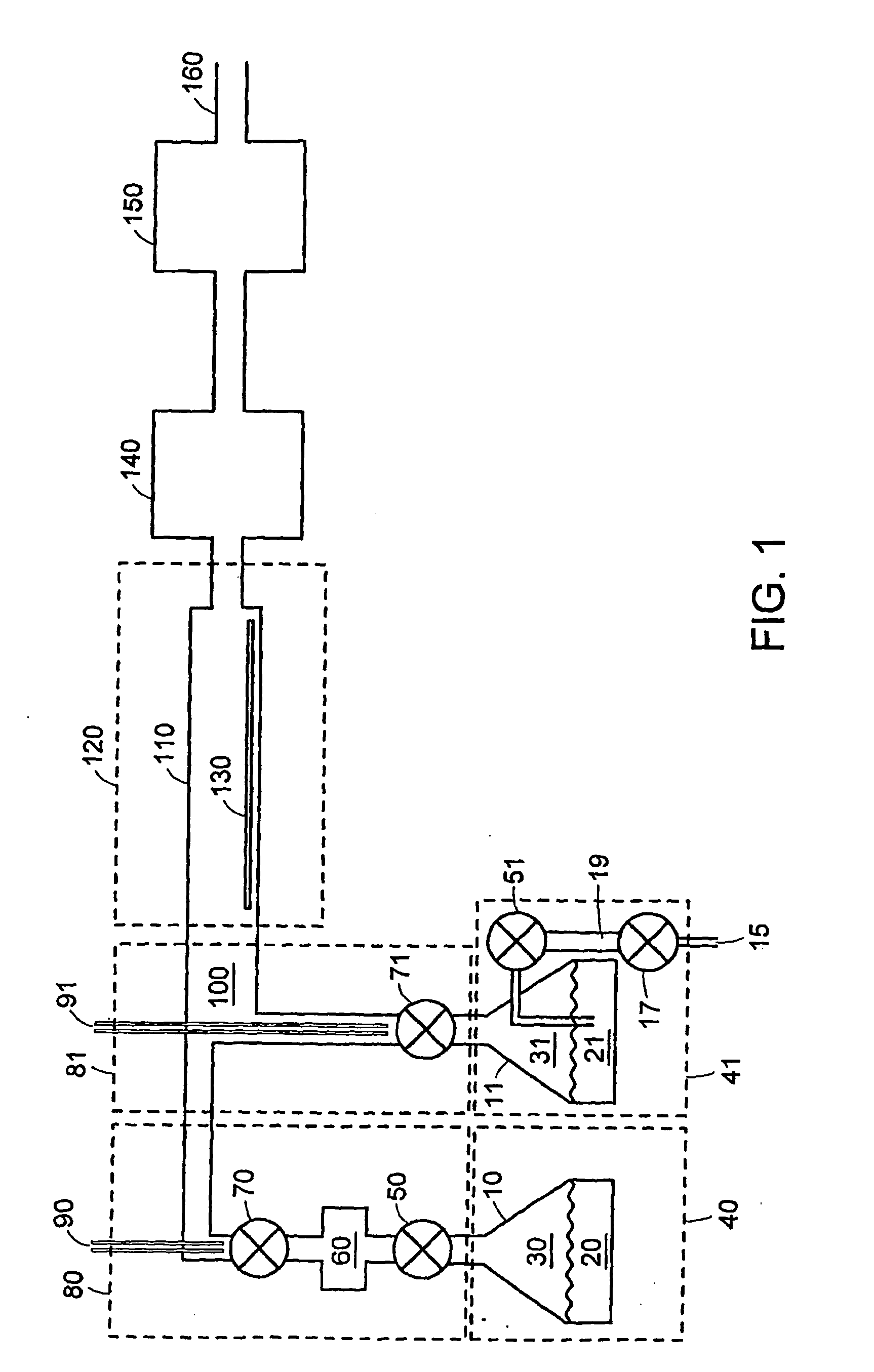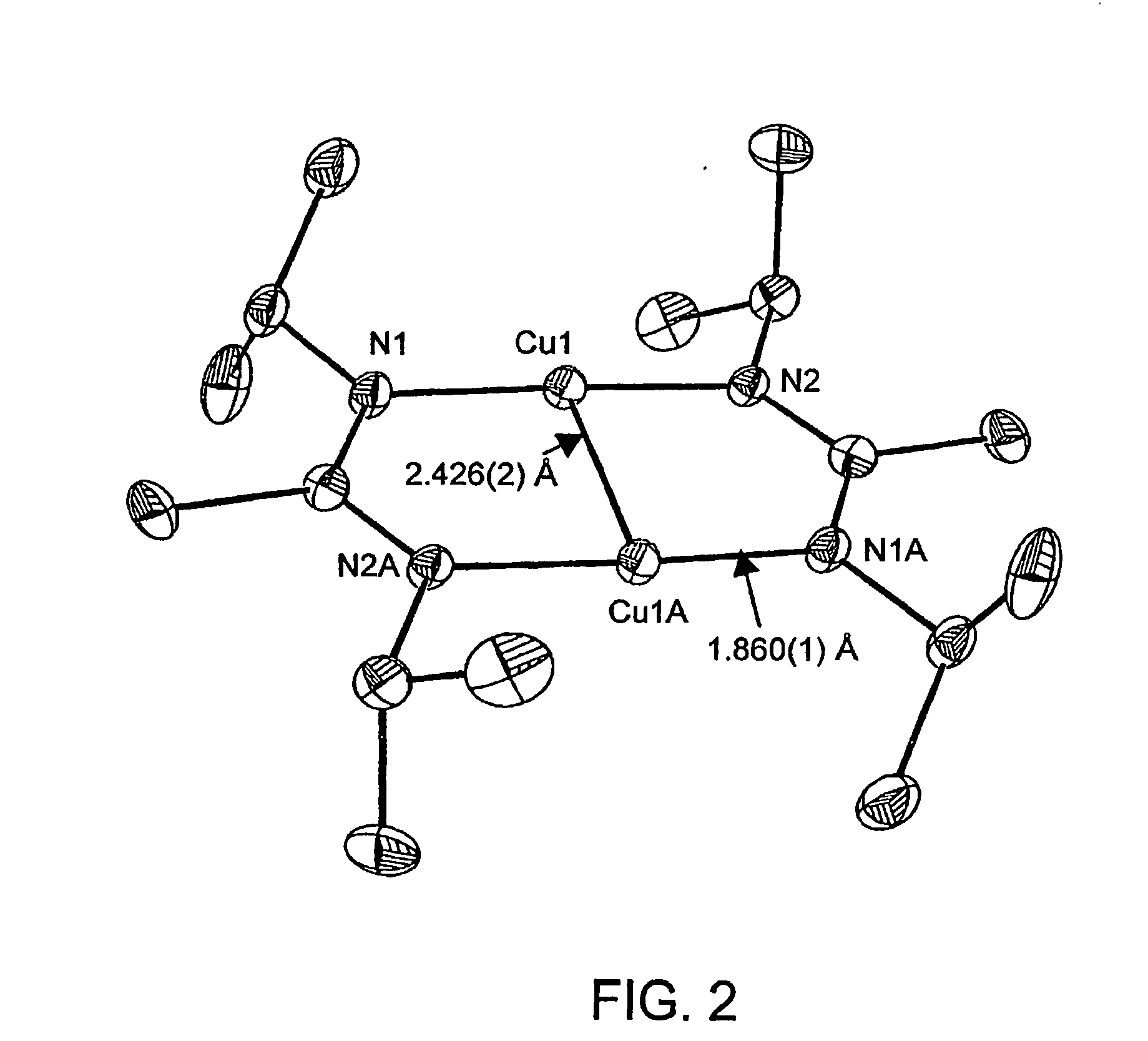Atomic layer deposition using metal amidinates
a technology of amidinate and atomic layer, which is applied in the direction of organic chemistry, coatings, gold organic compounds, etc., can solve the problems of self-limiting ald reactions, no data published to demonstrate that the proposed surface reaction is actually self-limiting, and the effect of high electrical conductivity
- Summary
- Abstract
- Description
- Claims
- Application Information
AI Technical Summary
Benefits of technology
Problems solved by technology
Method used
Image
Examples
example 1
Synthesis of (N,N′-diisopropylacetamidinato)copper ([Cu(iPr-AMD)]2)
[0077]A solution of methyllithium (1.6 M in ether, 34 mL, 0.054 mol) in ether was added dropwise to a solution of 1,3-diisopropylcarbodiimide (6.9 g, 0.055 mol) in 100 mL of ether at −30° C. The mixture was warmed up to room temperature and stirred for 4 h. The resultant colorless solution was then added to a solution of copper bromide (7.8 g, 0.054 mol) in 50 mL of ether. The reaction mixture was stirred for 12 h under the exclusion of light. All volatiles were then removed under reduced pressure, and the resulting solid was extracted with hexanes (100 mL). The hexanes extract was filtered through a pad of Celite on a glass frit to afford a pale yellow solution. Concentration of the filtrate and cooling it to −30° C. afforded 9.5 g of colorless crystals as a product (83%). Sublimation: 70° C. at 50 mTorr. 1H NMR (C6D6, 25° C.): 1.16 (d, 12H), 1.65 (s, 3H), 3.40 (m, 2H). Anal. Calcd for C16H34N4Cu2: C, 46.92; H, 8.37...
example 2
Synthesis of bis(N,N′-diisopropylacetamidinato)cobalt ([Co(iPr-AMD)2])
[0079]This compound was obtained in a similar manner as described for [Cu(iPr-AMD)], but with a 1:1 mixture of ether and THF as solvent. Recrystallization in hexanes at −30° C. gave dark green crystals as product (77%). Sublimation: 40° C. at 50 mTorr. m.p.: 72° C. Anal. Calcd for C16H34N4Co: C, 56.29; H, 10.04; N, 16.41. Found: C, 54.31; H, 9.69; N, 15.95.
[0080]Co(iPr-AMD)2, shown in FIG. 3, is monomeric with two amidinate ligands arranged about each cobalt atom in a distorted tetrahedral environment. The average Co—N distance is 2.012(8) Å. The Co—N—C—N four-membered rings are planar with an imposed mirror plane.
example 3
Synthesis of cobalt bis(N,N′-di-tert-butylacetamidinate) ([Co(tBu-AMD)2])
[0081]This compound was obtained in a manner similar to ([Co(iPr-AMD)2]) in Example 2, using 1,3-di-tert-butylcarbodiimide in place of 1,3-diisopropylcarbodiimide. Dark blue crystals (84%). Sublimation: 45° C. at 50 mtorr. m.p.: 90° C. Anal. Calcd for C20H42N4Co: C, 60.43; H, 10.65; N, 14.09. Found: C, 58.86; H, 10.33; N, 14.28.
PUM
| Property | Measurement | Unit |
|---|---|---|
| temperature | aaaaa | aaaaa |
| coverage | aaaaa | aaaaa |
| vaporization temperature | aaaaa | aaaaa |
Abstract
Description
Claims
Application Information
 Login to View More
Login to View More - R&D
- Intellectual Property
- Life Sciences
- Materials
- Tech Scout
- Unparalleled Data Quality
- Higher Quality Content
- 60% Fewer Hallucinations
Browse by: Latest US Patents, China's latest patents, Technical Efficacy Thesaurus, Application Domain, Technology Topic, Popular Technical Reports.
© 2025 PatSnap. All rights reserved.Legal|Privacy policy|Modern Slavery Act Transparency Statement|Sitemap|About US| Contact US: help@patsnap.com



